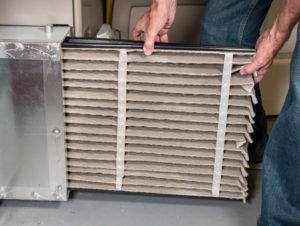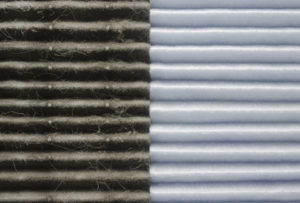Three Easy Things To Check When Your Heater Blows Cold Air

Why Is My Heater Blowing Cold Air in Cape May or Atlantic County?
Here are four things to check if your heater’s blowing cold air in the winter:
- Your Thermostat is Set to Cool
- The Air Filter is Clogged
- Your Vents Are Blocked
- The Furnace is Oversized
The last thing you want to feel when you turn on your furnace for the winter is a sudden blast of cold air. And, it’s even worse if you can’t figure out how to get things warm again.
In some cases, you need a professional. But, the good news is that the issue may be small and simple enough for you to fix yourself.
In the article, we’ll go over three easy ways to troubleshoot a heater blowing cold air. You’ll notice, however, there are four points listed above here.
That’s because the last one will require a professional. But, with any luck, things won’t get that far.
Meanwhile, if you have any questions or thing you need more help, don’t hesitate to reach out to us here at Broadley’s.
Your Thermostat is Set to Cool

Most thermostats have three “on” settings: Heating, Cooling, and Fan Only.
For the summer, you put it on cool. And, it’s really easy to forget to switch it when the weather gets cold.
After all, it’s been off for a while. As the temperature drops, you may just turn on the heat and forget about it.
So, if you’re getting cold air when you want heat, start with the gauge. If it’s on cool, you get cold air. And, “Fan Only” just circulates the air — which is likely cold, if it’s cold outside.
The Air Filter is Clogged

Your air filter is responsible for preventing debris, dust, and dirt as it passes through your ductwork and system. The idea is to prevent it from circulating through your air or building up inside the furnace.
It’s a simple contraption: A cloth screen spread over a frame. Eventually, it gets so full that not even air can pass through it.
When that happens, heat also backs up in the system. And, even though your furnace is there to give you hot air, it’s not supposed to store it.
The inner components aren’t made to remain that hot. Eventually, excess heat causes damage.
So, the system will turn itself off before there’s about to be a problem. Part of that is also cooling down the inside of the unit.
It does that by switching to cool air. And, you feel that gust of cold through your vents as that corrective measure makes it way through the ductwork.
To see if this is the problem, pull out your air filter. When it went in, it was white. The darker it is, the more dirt — and probably clogged — it is.
If you change the filter and the problem goes away, you’re all set. If not, move on to the next step.
Your Vents Are Blocked

When you put something closer than that or block it completely, the air can’t get out.
And, when that happens, you end up with that same problem as before: The heat backs up into the system. Too much and the system shuts off the heat and switches to cool.
Of course, we’re going to tell you to clear all the vents and see if that solves the problem. But, there’s more to consider.
Namely: what happens when it goes on too long.
The process of shutting down and blowing cold air is only a quick fix. It’s not sustainable.
Eventually, the sudden, drastic temperature changes take their toll. It weakens the parts inside the system. And, finally, one will break.
The problem is, the part that goes is usually one you can’t replace: the heat exchanger.
We went over this in detail in our last blog, which you can read here.
But, the long and short of it is that if this part breaks, you need a new furnace.
So, it’s essential to get to the bottom of the problem quickly. The faster you do, the less likely you are to have a catastrophic breakdown in the middle of the winter.
So, if you’ve gone this far without fixing the problem, it’s time for a professional. And, unfortunately, there’s one problem that doesn’t have an easy fix.
The Furnace is Oversized

You’d think bigger is better, right? The stronger your furnace, the better heat you’ll have, and the more comfortable you’ll feel.
Well, it doesn’t work like that.
Here’s what happens instead.
When your furnace kicks on, it blasts warm air through the vents. And, part of that design involves slowly and steadily filling your home with heat.
The problem with an oversized furnace is that there’s way too much heat at once. Then, a few things can happen.
One is that the heat has nowhere to go. There’s just too much too soon, and it backs up into the system.
We’ve gone over, in detail already, what happens then.
The problem also occurs if that extra-strong heat hits the thermostat way too hard. It reads an exceptional, sudden rise in temperature as a problem that triggers the system to blow cold air again.
Now, the problem here is that, unless you have a variable-speed unit, there’s no way to make your furnace work at a lower level. So, you’ve got two options.

And, with more vents, that extra heat has somewhere to go.
It’s doable, but it’s not cheap. The cost to asses the situation, design new outlets, and then fabricate and install it can easily cost more than $1,000.
The other option is to start over with a new furnace.
Going that route is much more expensive. But, you should take into account the age and condition of your current system. If it’s over or even approaching 20 years old, or if it’s showing signs of wear, moving up your investment could be the way to go.
There’s a lot to consider here. That’s from figuring out what the problem is, to how to make the right decision if you require an expensive fix. Fortunately, you don’t have to do it alone.
You can call or email us here at Broadley’s for any HVAC problems. We’ve been in business for nearly a century, and have an excellent reputation throughout South Jersey. We’ll help you get to the bottom of the problem and get your home comfortable again.




